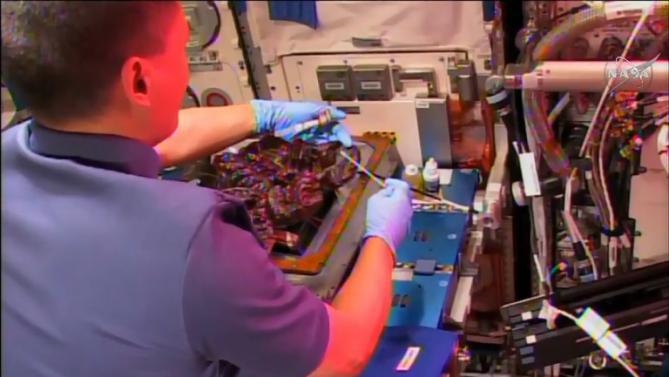
"That's great," said NASA astronaut Kjell Lindgren, after he ate a piece of red lettuce that was grown in a special box. "Tastes good," agreed US astronaut Scott Kelly, who is spending one year at the research station. "Kind of like arugula," Kelly added, then used small bottles to spread extra virgin olive oil and vinegar on his leaf, much as one might spread mustard on a hot dog.
NASA says that if space explorers can grow their own food while they are away from the Earth they would be more likely to survive the deep space exploration, which can last months or even years. With no way to resupply a spacecraft making a long journey to and from Mars, the ability to grow food during the trip will be key to survive. "Having the ability for us to grow our own food is a big step in that direction," he said.
Ray Wheeler, NASA's lead scientist for advanced life support activities at Kennedy Space Center in Florida, also said fresh foods such as tomatoes, blueberries and red lettuce, "could have a positive impact on people's moods and also could provide some protection against radiation in space."
The red romaine lettuce was grown in a special plant-growing box called a Veggie unit that was built by Orbital Technologies Corporation in Madison, Wisconsin, and was flown to space aboard the SpaceX Dragon cargo ship. The seeds are contained in rooting pillows, which come complete with soil and fertilizer. Since water cannot be poured in space, a special irrigation system delivers moisture to the plant pillows from below.
The seeds were "activated" by Kelly on July 8 and grew for 33 days. On Monday, Lindgren used tongs to harvest the lettuce from its growing box, before attaching the leaves carefully to a tray. He cleaned them with food-safe bag, to Kelly and Japanese astronaut Kimiya Yui. They saved a couple of leaves for Russian cosmonauts Mikhail Kornienko and Gennady Padalka, who were outside the station doing a spacewalk.
A previous crop of lettuce was grown in space last year but was not eaten by astronauts. Instead, it underwent-and passed-food safety tests back on Earth.
本时文内容由奇速英语国际教育研究院原创编写,禁止复制和任何商业用途,版权所有,侵权必究!
1.How did Kelly prepare the space-grown lettuce?
A He cooked it in a special box.
B He ate it with a kind of arugula.
C He put some mustard with it.
D He put the virgin olive oil on it.
解析:选D。D。细节理解题。根据文章第1段第3句的...then used small bottles to spread extra virgin olive oil and vinegar on his leaf...可以得知Kelly往叶子上撒了原生橄榄油然后才开始吃的。
2.The underlined words “that direction” in the second paragraph may refer to _____.
A The journey to and from Mars
B The way to grow food
C The building of research station
D The ability of flying in space
解析:选A。A。词意推测题。根据第2段第2句的With no way to resupply a spacecraft making a long journey to and from Mars...可知那个方向指的是来往火星的旅程。
3.What Ray Wheeler said means ______.
A the lettuce is a great step enabling human to travel to Mars
B human are not able to arrive at Mars without the lettuce
C tomatoes are obviously better than the blueberries in size
D radiation would be reduced if people don’t eat some lettuce
解析:选A。A。推理判断题。根据第3段的...could have a positive impact on people's moods and also could provide some protection against radiation可知该蔬菜能够帮助人们抵御来自火星的辐射,使人们能够去火星旅行。
4.What is difficult in growing lettuce in space?
A There is no enough growing area.
B It is very hard to send up the seeds.
C The special way of watering is needed.
D It does not need soil or the fertilizer.
解析:选C。C。推理判断题。根据第4段最后1句的Since water cannot be poured in space, a special irrigation system delivers moisture to the plant pillows from below可知在太空给植物浇水是很困难的。
5.How many astronauts are in the space station?
A 2
B 3
C 4
D 5
解析:选D。D。细节理解题。 根据第5段的叙述不难得知,空间站上的人有:Lindgren、Kelly、Kimiya Yui、Mikhail Kornienko、Gennady Padalka总共5个人。